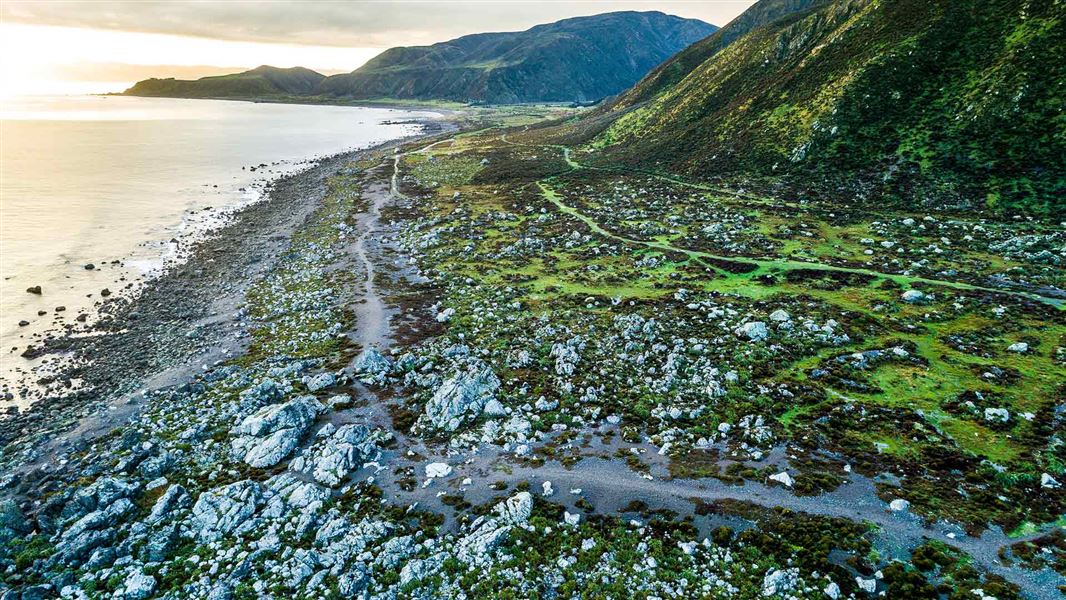Turakirae Head Scientific Reserve is located approximately 20 km south of Wainuiomata, at the end of the Coast Road.
The public road ends 3 km short of Turakirae Head. You must park your vehicle in the public carpark 300 m before the end of the public road. From the carpark, walk along the road and over the Ōrongorongo River Bridge. Access to Turakirae Head is gained via a covenant area on private property. Pass through a gate in the fence just over the river. Follow the seaward side of the fence to the reserve.
Access to Turakirae Head is through Ōrongorongo Station which is a working farm and private property. Visitors must respect the following conditions:
- Keep to the seaward side of the fence.
- Access is by foot only, vehicles of any type are prohibited.
- Dogs are not permitted on the Station or in the scientific reserve.
- Fires may not be lit anywhere in this area because of the high risk to vegetation.
Water safety - Diving, surfing and other water activities
Turakirae Head faces south with no shelter. In severe weather the waves and currents will be significant. In an offshore wind it can be easy to get swept out to sea. Currents may also move you in unexpected directions, seek advice from locals before entering the water if possible.
This is a remote location. If someone gets into trouble in the water, help is some time away. Consider how you would get help if needed. Check whether there is coverage on your network. Take two waterproof forms of communication, for example, an extra phone in a waterproof bag or even better a distress beacon. Ensure someone knows your plans and will raise the alarm by calling 111, if you don’t return .
We recommend that you:
- always dive or surf with a buddy
- seek local knowledge on the area before going
- always make sure you have a visible float/flag, if you are diving
- check your gear
- don’t exceed your limits.
Read more about free diving and snorkelling, surfing and boating and fishing safety.
The name Turakirae tells us that this is the headland (rae) where the Rimutaka Range comes down (turaki) to the sea. Turakirae Head Scientific Reserve provides valuable habitat for a variety of plants and wildlife, most notably seals, and preserves a well-defined sequence of earthquake-raised beaches.
It takes about 45 minutes to walk to Turakirae Head. Fur seals are present in highest numbers during winter. Never approach seals too closely, and do not get between a seal and the sea.
Wildlife
Up to 500 New Zealand fur seals stay at Turakirae Head each winter. The colony mainly comprises juvenile males, which spend their time here building up condition before moving to breeding colonies in other areas. During the breeding season they will not eat for three months or more, living off the fat reserves they build up over winter.
This colony began in 1950 and has steadily increased since then to become the largest haulout on the south Wellington coast.
Turakirae Head Scientific Reserve also provides habitat for a variety of native birds and reptiles.
Banded dotterel, caspian tern and variable oystercatcher are among the bird species that may be observed. Copper skink, spotted skink, common skink and common gecko are all present within the reserve.
Geological features
The five earthquake-raised beaches are internationally-renowned in scientific circles for the continuous record they provide of geological upheaval over the past 7,000 years.
The most recent uplift occurred in 1855 when an earthquake measuring 8 on the Richter scale raised the beach 2.5 metres at Turakirae Head and 1.7 metres in Wellington Harbour. The second beach ridge was uplifted by a similar ’quake around 1460 AD. This is now about 8 metres above sea level and is separated from the 1855 beach by a platform of large boulders. A similar platform separates the third beach at about 16 metres above sea level. This beach is estimated to have been uplifted about 3000 years ago.
Two other ridges are mostly obscured by screes from the steep slopes behind. They occur at 22 and 25 metres above sea level.
Evidence of much earlier uplift can be seen in the hills west of the Orongorongo River.
Vegetation
The vegetation within the Turakirae Head Scientific Reserve consists of a mixture of salt tolerant herbs, tussock and reed associations, dune associations and coastal forest. Fire, both pre-European and more recent, has been the principal environmental factor influencing the present vegetation pattern. The vegetation is still subject to grazing by sheep, cattle and rabbits.
A nationally-threatened plant, the shrubby tororaro, Muehlenbeckia astonii, occurs within the reserve. A new population of shrubby tororaro was established at Turakirae Head in 1998 as part of a programme to avert the extinction of the species.
| Wellington/Kapiti information | |
| Phone: | +64 3 546 9339 |
| Email: | nelsonvc@doc.govt.nz |
| About: | Whakatū/Nelson Visitor Centre provides visitor information for this area |
